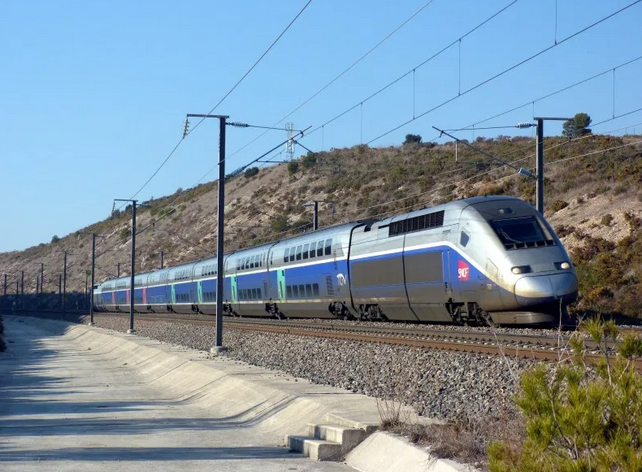The California High-Speed Rail Authority (CAHSRA) is delaying the next round of construction contract signing from September until December. This phase of the contracts, worth $1.6 billion, is for 119 miles of track systems and electrification--basically, everything that sits on top of the bridges and tunnels that are already built. "It's what allows you to run trains on it," explained Boris Lipkin, Northern California Regional Director for the project.
Meanwhile, the Los Angeles Times is framing this as a capitulation to Southern and Northern California Assemblymembers pushing to divert that money from the Central Valley to projects in their districts.
However, Lipkin told Streetsblog the decision to delay is actually about the pandemic. "When COVID hit, what we heard back from some of the bidders was that it had caused ripples through financial markets, so they asked for more time to evaluate what those implications are."
It might make sense from another perspective: if Biden and the Democrats sweep Washington, which polls show is likely, more money will come from the Feds. The Obama Administration provided $3.5 billion in 2008 for CAHSRA and one would expect his Vice President, himself one of the biggest rail boosters in Washington, to provide far more. Lipkin, however, said the contracts in question are the next step regardless of what happens in November.
In the meantime, "all of the work that has been going on around the state will continue to advance. This includes construction work, environmental reviews, bookend projects, and our necessary procurements to meet our federal requirements. We are not slowing down," said Annie Parker, a spokesperson for CAHSRA.
There are roughly $5 billion worth of bridges, trenches, berms, and acquired right-of-way in the Central Valley, and more is being built every day. However, as Streetsblog has previously reported, some Southern and Northern California politicians want to abandon this work and send the remaining cash to unspecified commuter rail improvements in their districts. Under their plan, low-speed tracks, sans electrification, would be installed on the civil works and the Central Valley spine of HSR would carry slow, polluting diesels.
In Streetsblog's view, this is politically infeasible. If the State Senate and Governor Brown weren't going to walk away from the Central Valley in 2012, when there wasn't over 100 miles of construction projects going on, how could Governor Newsom and this Assembly and Senate justify it now? They would leave behind an incredibly expensive set of HSR civil works that can't run HSR, merely duplicating the freight tracks Amtrak already uses for its San Joaquin service between the Bay Area and Bakersfield. Moreover, Newsom has already said, several times, that he's committed to finishing the Central Valley spine--labor unions would rip him a new one if he reneged.
Plus the contention from Northern and Southern California politicians that they should get the funds next because they have more people belies reality: HSR is already contributing to rail projects in L.A. and the Bay Area, such as Caltrain electrification and important upgrades to L.A.'s Union Station.
That said, it's amusing to read the LA Times fantastical coverage. Here are excerpts from their reporter on the beat, Ralph Vartabedian, on the push to divert funds from the Central Valley to L.A. and the Bay Area:
"In a major shift in thinking about the state’s bullet train, powerful transportation agencies in Northern and Southern California want to quickly obtain up to half the project’s bond financing to upgrade local rail corridors that could become part of the proposed high-speed network," he writes. In another piece he writes: "In a scathing critique that could further jeopardize political support for California’s proposed $98.5-billion bullet train, a key independent review panel is recommending that state officials postpone borrowing billions of dollars..."
And here's the most recent one: "Following a stunning rebuke by the State Assembly, the board of California’s high-speed rail authority this week put off approving a crucial 2020 business plan, a sign it has agreed to reassess the project’s current blueprint."
"A major shift," "scathing critique" and a "stunning rebuke"--it must finally be over for California HSR.
Except the first two quotes are actually from stories he wrote in 2012, when SoCal politicians attempted to quash the Central Valley groundbreaking to divert the initial funds to their districts (as politicians do). The "stunning rebuke" is because of the aforementioned contract delays because of COVID-19.
It's almost as if Vartabedian isn't so much a reporter as a tool, writing at the behest of the Koch Brothers and Chevron, attempting to forge an alternate reality where HSR is going nowhere, even now that concrete is being poured every day across over 100 miles of the Central Valley. Whatever he writes, however, the concrete and steel are real.
For the record, here's a screen shot from a CAHSRA memo from Dec. 2019, showing that the contract in question was supposed to be awarded in September:
Note it specified that "the schedule may be revised based on developments during the procurement." Streetsblog submits that the COVID-19 pandemic qualifies as a "development."






